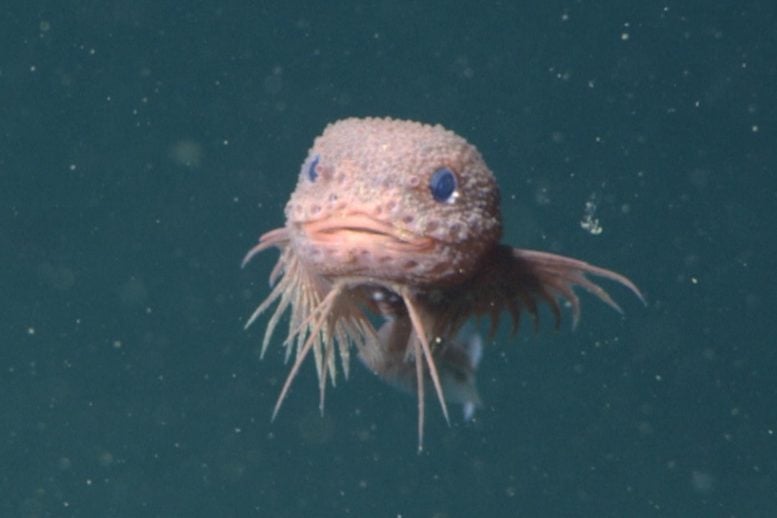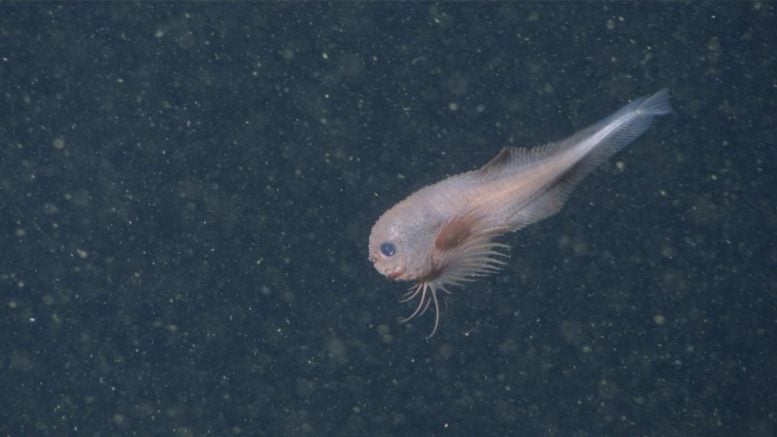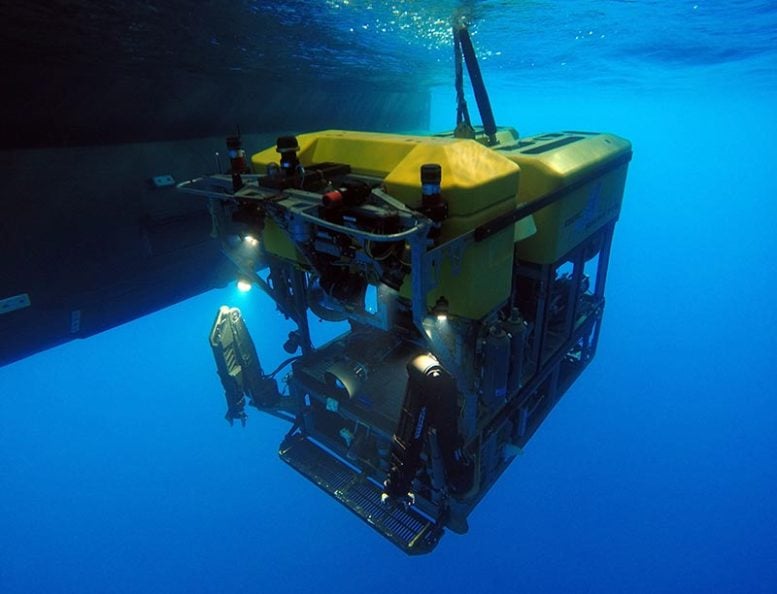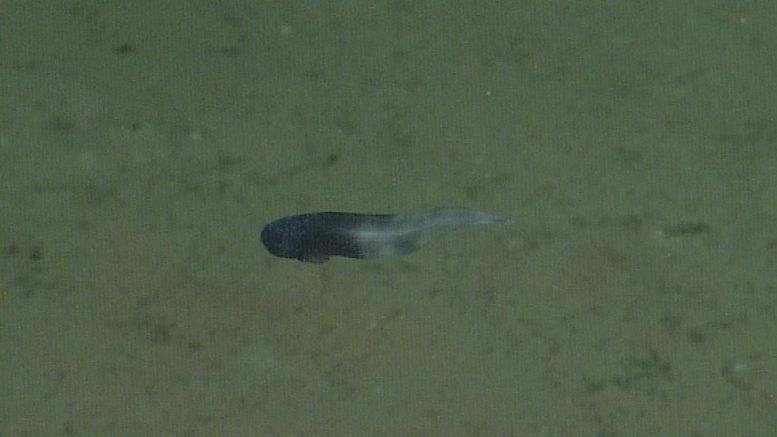
The bumpy snailfish is certainly one of three newly recognized deep-sea snailfish species described by MBARI collaborators at SUNY Geneseo.
MBARI’s cutting-edge underwater tools are uncovering unique species that inhabit the deep ocean. In 2019, researchers observed a pink snailfish gliding just above the seafloor that did not match any known species. Follow-up research has now confirmed that this fish is a newly identified species, the bumpy snailfish (Careproctus colliculi).
Scientists from the State University of New York at Geneseo (SUNY Geneseo), working with colleagues from the University of Montana and the University of Hawaiʻi at Mānoa, reported their findings in the journal Ichthyology and Herpetology. Their publication describes the bumpy snailfish documented by MBARI researchers along with two additional snailfish species found on the abyssal seafloor off the coast of California.

“MBARI seeks to make ocean exploration more accessible by sharing our data and technology with our peers in the science community. We welcomed the opportunity to collaborate with researchers from SUNY Geneseo to expand our understanding of life in the deep ocean, especially since documenting deep-sea biodiversity is critical to detecting any changes that may be occurring in this environment,” said MBARI Senior Scientist Steven Haddock, who led the research expedition that encountered the bumpy snailfish.
Uncovering secrets to survival in extreme environments
Snailfishes are members of the family Liparidae. They are characterized by their large heads, soft, gelatinous bodies with loose skin, and slender tails. Many species possess a specialized disk on their underside that helps them attach to the seafloor or even ride along on larger animals like deep-sea crabs. In shallower waters, some species use this disk to cling to rocks and seaweed, curling their bodies much like a snail.
More than 400 species of snailfish have been formally identified across the globe. They occupy an impressive range of marine environments, from coastal tide pools to the planet’s deepest ocean trenches. In fact, the deepest-living fish ever recorded is a snailfish.

At SUNY Geneseo, Associate Professor Mackenzie Gerringer focuses on deep-sea snailfishes while studying physiology and ecology in extreme environments. Her research combines taxonomy, functional morphology, and physiology to uncover how these fishes survive in conditions defined by immense pressure, freezing temperatures, and constant darkness.
“The deep sea is home to an incredible diversity of organisms and a truly beautiful array of adaptations. Our discovery of not one, but three, new species of snailfishes is a reminder of how much we have yet to learn about life on Earth and of the power of curiosity and exploration,” said Gerringer.
Chance encounters spark new discoveries
MBARI’s Biodiversity and Biooptics Team noticed the newly described bumpy snailfish throughout an expedition aboard the institute’s retired flagship analysis vessel Western Flyer. Haddock and his workforce have been exploring the outer reaches of Monterey Canyon, roughly 100 kilometers (62 miles) offshore of Central California, with MBARI’s remotely operated automobile Doc Ricketts at a depth of three,268 meters (10,722 ft) once they noticed this small snailfish swimming above the abyssal seafloor.
MBARI researchers collected this particular person—an grownup feminine 9.2 centimeters (3.6 inches) lengthy—for additional examine within the laboratory. With options not like different deep-sea snailfishes that MBARI had encountered offshore of California, Haddock reached out to Gerringer for extra detailed evaluation. MBARI regularly collaborates with knowledgeable taxonomists to evaluation footage and specimens. These partnerships supply contemporary views that always spark new discoveries.
New additions to the household
Gerringer and researchers from the University of Montana and the University of Hawaiʻi at Mānoa, together with former MBARI postdoctoral fellow Jeff Drazen, examined the bumpy snailfish as a part of a complete evaluation of three uncommon snailfish specimens collected offshore of California. The workforce mixed imaging, morphological, and genetic approaches to check these snailfishes to different identified fishes.

Using microscopy, micro-computed tomography (micro-CT) scanning, and cautious measurements, the workforce collected detailed details about the scale, form, and bodily traits of the three fishes, distinguishing them from all identified species. They additionally sequenced the DNA of the specimens to compare these animals to other snailfishes and determine their evolutionary position in the family Liparidae. Their examination confirmed that all three snailfishes were new to science. The team has made their CT scan data publicly available via MorphoSource and genetic sequence data via GenBank (PV300955-PV300957 and PV298545-PV298546).
In addition to the bumpy snailfish, the SUNY Geneseo team described the dark snailfish (Careproctus yanceyi) and the sleek snailfish (Paraliparis em).
The bumpy snailfish has a distinctive pink color, a round head with large eyes, wide pectoral fins with long uppermost rays, and a bumpy texture. The dark snailfish has a fully black body with a rounded head and horizontal mouth. The sleek snailfish is distinguished from other snailfishes by a long, black, laterally compressed body, absence of a suction disk, and prominently angled jaw.
Both the dark and sleek snailfishes were collected in 2019 by Drazen and colleagues during an expedition with the submersible Alvin at Station M, a research site operated by MBARI offshore of Central California at a depth of approximately 4,000 meters (13,100 feet). MBARI scientists and researchers worldwide have leveraged a unique 30-year dataset collected by a suite of advanced instruments at Station M to make several important discoveries about abyssal ecosystems and the ocean-climate connection. The species name of the sleek snailfish, Paraliparis em, recognizes this unique research site and the people and programs that have supported the Station M time series.
Haddock’s encounter is the only confirmed observation of the bumpy snailfish, so the full geographic distribution and depth range of this species remain unknown. However, a closer look at MBARI’s extensive archive of underwater video suggests this species may have been previously encountered offshore of Oregon in 2009 and mistaken for a similar species, the bigtail snailfish (Osteodiscus cascadiae).
Cataloging life in the depths
The deep sea is the largest living space on Earth. The inky waters beneath the ocean’s surface teem with life, including many species unknown to science. With threats like climate change and mining putting deep-sea communities at risk, documenting the residents of this environment is more urgent than ever.
Over the past 38 years, MBARI researchers and our collaborators have discovered more than 300 new species. We share video footage and specimens with taxonomy experts around the world, giving other researchers access to the deep sea. MBARI science and technology are helping establish a baseline understanding of ocean health and deep-sea biodiversity so we can better assess how climate change, pollution, mining, and other human activities will affect the marine ecosystems. From the mesmerizing “mystery mollusk” to the carnivorous harp sponge, each discovery is a new piece of the puzzle.
Reference: “Descriptions of Three Newly Discovered Abyssal Snailfishes (Liparidae) from the Eastern Pacific Ocean” by Mackenzie E. Gerringer, Sarah Suplicz, Jessica L. Palmeri, Lydia Fregosi, Brett H. Woodworth, Emily McMahon, Samantha Shepard, Logan M. Peoples and Jeffrey C. Drazen, 27 August 2025, Ichthyology & Herpetology.
DOI: 10.1643/i2024069
Funding for this work was provided by the U.S. National Science Foundation Division of Ocean Sciences (OCE-1829612), the David and Lucile Packard Foundation, and the SUNY Geneseo Research Foundation.
Never miss a breakthrough: Join the SciTechDaily newsletter.
